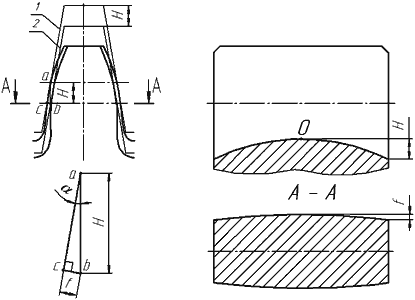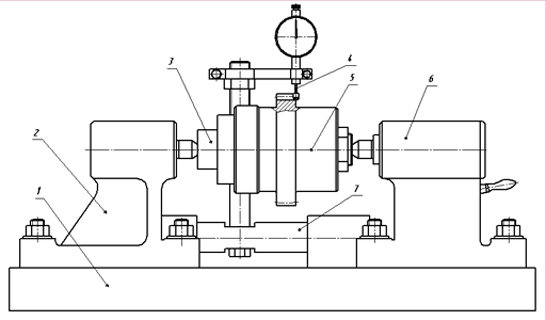

Faculty of Engineering Mechanics and Mechanical Engineering
Speciality: Technology of mechanical engineering
Gear couplings are widely used in modern engineering for connecting elements that transmit torque in the various mechanisms.
With the development of technique great importance is the problem of increasing wear resistance and reliability of machine parts, including gear couplings.
Most of the failures of machines is asso-ciated with wear of gear couplings, their breakage or increasing the vibration of machines, which cause an increase in the gap in engagement clutch.
It is known that in the process of gear couplings the load perceived by a limited number of diametrically opposite teeth.
To solve this problem, necessary to increase the number of teeth, which transmit the load by changing the design of hub holder or bush, reducing the width of the tooth bush and increase the distance between the gear rings bush.
Gear couplings are made of structural steel 45, which has a low contact strength. To improve the reliability and durability of the gear couplings can be used more wear-resistant steel alloy, such as manganese, the use of surface-plastic processing and chemical-heat treatment, surfacing and spraying more wear-resistant materials.
Of great importance in reducing the wear of teeth of gear couplings have the correct lubricant, which should minimize the formation of wear particles and to reduce abrasive wear. In addition, the grease should prevent the emergence of contact corrosion, as well as seizure and galling. The maximum effect is achieved by using oils with additives.
The purpose of this work is to improve the wear resistance and durability of gear couplings throughout the life cycle: during design, manufacture and operation.
To achieve this goal it is necessary to solve the following problem:
To perform research the work of gear couplings in terms of increasing their longevity and reliability.
To explore and to develop design methods to improve the wear resistance of gear couplings.
To explore and to develop technological methods of increasing the durability of gear couplings.
To explore and to develop operational methods to improve the wear resistance of gear couplings.
Develop recommendations based on studies.
The analysis of the work on developing methods for improving the wear resistance of machine parts, including gear couplings throughout their life cycle showed that, despite the vigorous exploration of this issue adequately investigated many options for working to design and manufacture of gear couplings.
Most of the work devoted to the study of design methods to enhance reliability and durability of gear couplings.
This master work is part of research that are conducting on the chair " Technology of mechanical engineering " of Donetsk National Technical University.
On the chair are conducting research to develop and study methods for increasing longevity and durability of gear couplings [1, 2, 3], are developing new designs of construction gear couplings to reduce their wear and impact on the support shaft [4, 5], developed new space-modified form tooth, which improves the options of contacting teeth meshing bushings and clutch holder.[6, 7, 8]
At this stage of the implementation of master work the proposed scientific novelty can be considered as a device for monitoring barreling teeth of gears or bushes of gear couplings.
Currently there is no reliable and accurate method of control barreling tooth gears. Known means of measuring the thickness of the tooth and the bias of original contour does not provide an accurate install them on any surface of the tooth or on the diameter of pitch circle.
Thus, the error installing the measuring device gives rise to measurement error, which may be greater than barreling.
Barrel-like shape is achieved by the bias of the original contour along the length of the tooth from its butt to the middle in the direction from the axis of the details and from the axis of the tooth. The diameter of the circle depressions in the various sections of the gear has different values, and the cylinder, which is formed depressions teeth becomes barrel-like shape. Value of barrel-like of cylinder H equal value to the bias of the original contour along in the direction from the axis of the details (Fig. 1).

Figure 1 – Situation of the original contour: 1 – in the middle of the tooth; 2 – at the end of the tooth
Relationship between the biasing of the original contour and the changing of the thickness of the tooth, that is value of barrel-like f can be determined from the triangle авс (рис. 1):
f = H • sin α (1)
where, f – value of barrel-like;
Н – value to the bias of the original contour;
α – angle profile of the original contour.
The design of device, allowing to carry out such measurements is shown in figure 2.

Figure 2 – The design of device for measuring the value of barrel-like of tooth:
1 – base; 2 – front ram; 3 – mandrel of gidroplastik; 4 – indicator; 5 – detail; 6 – back ram; 7 – cylindrical guide
(Animation: the number of frames - 6, the number of cycles - 10, size - KB 101)
To determine the value of barrel-like of tooth measured the value biasing of the original contour.
For this piece 5, pre-installed on mandrel of gidroplastik 3, is installing in the centers of 2 and 6 of devices.
Measuring tip of indicator 4 is setting at the end of the tooth cavity and is zeroing. Then the indicator is moving along the tooth to the point where the deflection indicator will be the maximum - this is the biasing of the original contour H on which is calculating the value of barrel-like tooth f.
As a result of the master's work should be developed methods, that will increasing wear resistance of gear couplings throughout the life cycle.
As a design method is planned to improve the design of the hub gear with a view to increase its susceptibility for better distribute the load between the teeth. At the moment, this problem is solving using the program ANSYS.
In the technological part of the master's work is planning to development the technological process of processing gear bushing. It will contain a non-traditional methods of processing, which will increase the wear resistance of parts when in service.
In the research section will examine in greater detail design, technology and operational methods to improve the wear resistance of gear couplings and will develop recommendations on the basis of that studies.
When writing this autosummary master's work was not completed. Completion - December 2010.
Польченко В. В., Азуз Талед, Недосекин В.Б., Луцкий С.В. Некоторые методы повышения долговечности зубчатых муфт // Прогрессивные технологии и системы машиностроения: Междунар. сб. науч. тр. - Донецк: ДонГТУ, 2000.-Вып.14. -С.152-158.
Польченко В.В., Москвин С.С. Влияние эксплуатационных параметров на износ зубчатых муфт // Прогрессивные технологии и системымашиностроения: Междунар. сб. науч.тр. - Донецк: ДонГТУ, 1999. - Вып. 7. - С. 155-165.
Польченко В.В., Соловей А.В. Изменение работоспособности зубча-тых муфт изменением податливости втулки // Прогрессивные технологии и системы машиностроения: Материалы V междунар.науч.-техн.конф.8-11сент.1998г., г. Севастополь. - Донецк: ДонГТУ,1998.-Т.3, вып. 6.
Польченко В.В., Богуславский В.В., Каплюхин А.А. Влияние конст-рукции зубчатых муфт на нагрузку опор валов // Практика i перспективи розвитку iнструментального партнерства: Вiстн. ДонНГУ - ТРТУ. - Донецьк: ДонДТУ, 2003.- С.138-143.
Михайлов А.Н., Грубка Р.М. Анализ влияния геометрических характеристик зубьев зубчатых муфт на параметры контактирования зубьев с пространственной модификацией // Прогрессивные технологии и системы машиностроения: Междунар. сб. науч. тр. - Донецк: ДонНТУ, 2002. - Вып.21. -С.
Ивченко А.Л., Польченко В.В., Сагуленко Н.Г. Влияние параметров механообработки на износостойкость деталей машин // Машиноведение и детали машин: Матер. регион. науч. - метод. конф. - Донецк: ДонГТУ, 2000.-С.29-31.
Финиченко В.А., Водолажченко А.Г., Осадчий А.С. Напряженно-деформированное состояние зубьев зубчатых муфт.[Electronic resource] - Access Regime http://www.nbuv.gov.ua/portal/natural/Ptsm/2008_36/261-263.pdf
Айрапетов Э.Л., Уткин Б.С., Лагутин С.А., Робер А.И. Совершенствование зубчатых муфт и шпинделей конструкции ЭЗТМ.[Electronic resource] - Access Regime http://new.gears.ru/pdf/air/air_s2.pdf